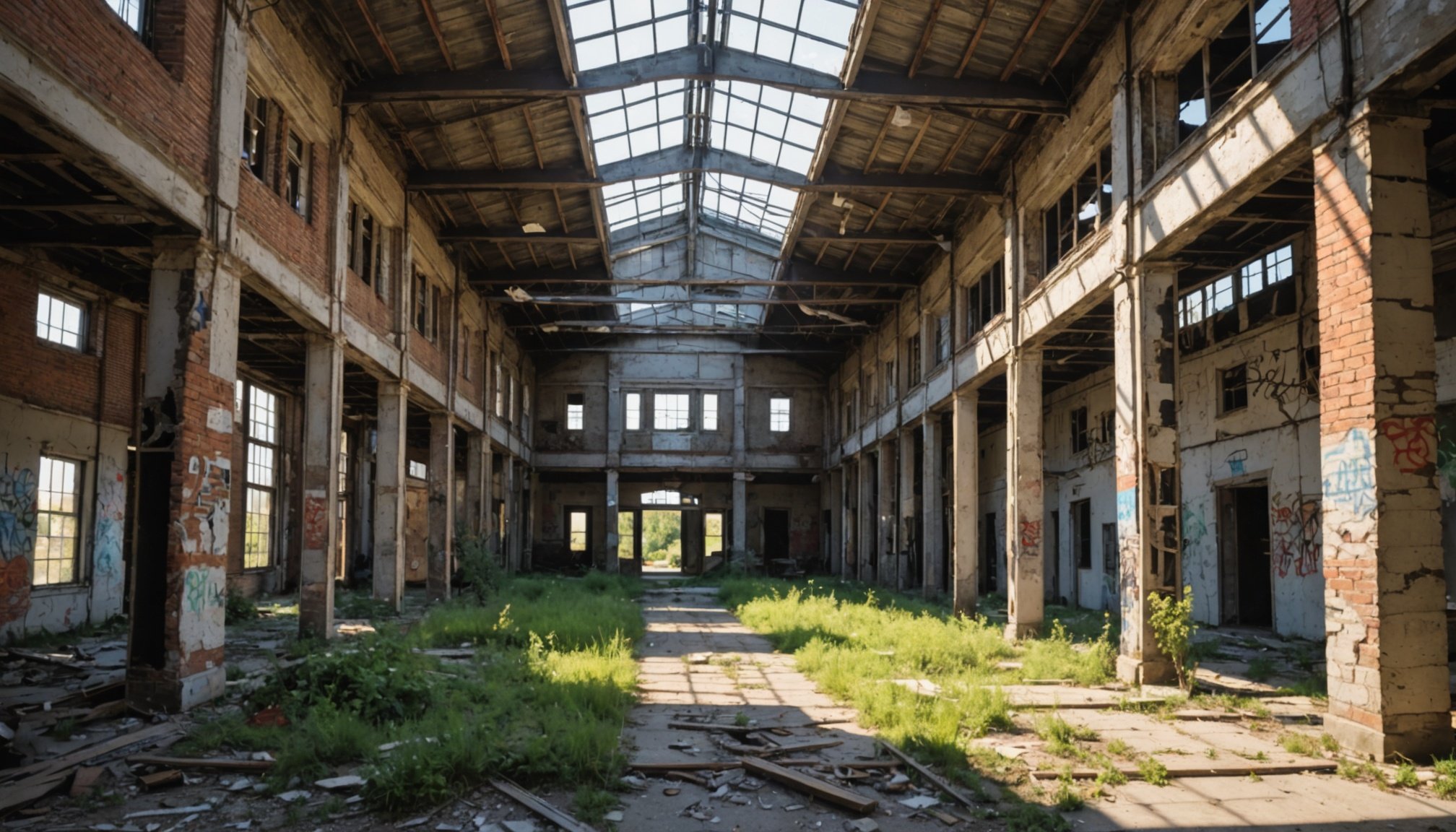Unlocking Urban Potential: Creative Approaches to Revitalize and Transform Abandoned Spaces
In the heart of many cities, there lie abandoned spaces that once held promise but now stand as testaments to neglect and disuse. However, with creative vision and innovative approaches, these spaces can be transformed into vibrant hubs of community activity, economic growth, and sustainable development. Here’s how cities around the world are unlocking their urban potential by revitalizing and transforming abandoned spaces.
The Power of Community Engagement
Community engagement is a cornerstone of any successful urban regeneration project. When local residents are involved in the planning and execution of these projects, it fosters a sense of ownership and collective responsibility.
Topic to read : Harmonizing Community and Commerce: Top Tactics for Thriving Mixed-Use Developments
Building Stronger Communities
A prime example of this is the concept of community gardens. These green spaces not only beautify urban areas but also serve as community hubs where residents can come together to grow their own food, share knowledge, and build relationships.
“Un jardin communautaire offre un impact positif essentiel sur la communauté environnante. Grâce à la revitalisation d’espace, il transforme des terrains vacants en oasis verdoyantes, attirant à la fois les résidents et les visiteurs,” highlights a manual on community gardens[1].
Topic to read : Revolutionizing Instant Property Valuations with Cutting-Edge AI Technology
These gardens promote biodiversity, provide access to fresh produce, and create spaces for recreation and relaxation, all of which are crucial for the mental and physical well-being of urban dwellers.
Adaptive Reuse: Breathing New Life into Old Buildings
Adaptive reuse is a strategy that involves repurposing existing buildings for new uses, thereby conserving resources and preserving the cultural and architectural heritage of urban environments.
From Warehouses to Residential Spaces
For instance, the Tate Modern in London was converted from a 1940s power station into a world-renowned art gallery. Similarly, in New York City, the High Line Hotel was once a dormitory for The General Theological Seminary and has since been transformed into a modern hotel[4].
This approach not only addresses urban housing shortages but also reduces the environmental impact associated with new construction. Here are some key benefits of adaptive reuse:
- Conservation of Resources: Adaptive reuse minimizes waste and utilizes existing materials, reducing the carbon footprint associated with new construction.
- Preservation of Heritage: It preserves the cultural and architectural significance of old buildings, maintaining the historical character of urban areas.
- Economic Revitalization: By converting underutilized properties into residential, retail, or mixed-use developments, cities can stimulate economic growth and revitalize neglected areas.
Urban Design and Mixed-Use Developments
Urban design plays a critical role in transforming abandoned spaces into thriving urban hubs. Mixed-use developments, which blend residential, commercial, and recreational spaces, are becoming increasingly popular.
Creating Connected and Sustainable Communities
In many cities, the focus is shifting towards designing urban spaces that prioritize pedestrians and cyclists over cars. This multi-modal transportation approach aims to create more connected, sustainable communities.
“By redesigning streets and infrastructure to prioritize pedestrians and cyclists, we’re moving away from car-centric designs and reducing the carbon footprint of cities,” explains an architectural trend report[2].
Here’s a comparison of traditional urban design versus modern, sustainable approaches:
| Aspect | Traditional Urban Design | Modern, Sustainable Urban Design |
|---|---|---|
| Transportation | Car-centric | Pedestrian and cyclist-friendly |
| Land Use | Single-use developments | Mixed-use developments |
| Green Spaces | Limited green areas | Integrated green infrastructure |
| Community Engagement | Minimal community involvement | High community engagement |
| Sustainability | High carbon footprint | Net zero or low carbon footprint |
The Role of Public Art in Urban Regeneration
Public art can be a powerful tool for transforming urban spaces and fostering community engagement.
Street Art as a Catalyst for Change
In Bushwick, New York, the Bushwick Collective has turned entire city blocks into an open-air museum, featuring works by artists from around the world. This project has not only revitalized the area but also created a vibrant cultural scene that attracts visitors and supports local businesses[3].
“Le street art devient un outil de sensibilisation de plus en plus puissant. Des artistes utilisent leurs œuvres pour aborder des questions sociales, politiques et environnementales urgentes, transformant les murs en véritables manifestes visuels,” notes an article on street art trends[3].
Here are some ways public art can contribute to urban regeneration:
- Social and Environmental Awareness: Public art can address pressing social and environmental issues, raising awareness and promoting change.
- Tourism and Economic Growth: Street art can become a tourist attraction, boosting local economies and revitalizing neglected areas.
- Community Identity: Public art can reflect the culture and identity of a community, fostering a sense of pride and belonging.
Green Infrastructure and Urban Planning
Green infrastructure is essential for creating sustainable and livable urban spaces. Urban planning that incorporates green spaces can mitigate the effects of climate change and improve the quality of life for urban residents.
Integrating Green Spaces into Urban Design
Community gardens, parks, and green roofs are examples of green infrastructure that can be integrated into urban design. These spaces not only provide aesthetic value but also help in managing stormwater runoff, reducing urban heat island effects, and improving air quality.
“Un jardin communautaire procure une oasis pour la faune locale grâce à la plantation d’espèces diversifiées. Cette activité aide à stabiliser l’écosystème urbain, augmentant la résilience environnementale face aux changements climatiques,” explains a guide on community gardens[1].
Here are some practical tips for incorporating green infrastructure into urban planning:
- Choose Climate-Resilient Plants: Select plants that are adapted to the local climate to ensure minimal maintenance and maximum benefits.
- Create Functional Zones: Designate different areas for different uses, such as vegetable gardens, ornamental plants, and rest areas.
- Integrate Natural Elements: Use natural elements like stone paths and recycled wood installations to enhance the aesthetic and sustainability of green spaces.
Policy and Economic Considerations
Effective urban regeneration requires supportive policies and economic incentives. Here’s how cities can create an environment conducive to revitalizing abandoned spaces.
Economic Incentives and Policy Support
Cities can offer incentives such as tax breaks, grants, and streamlined regulatory processes to encourage developers to undertake adaptive reuse projects. For example, the initiative by Dune Real Estate Partners and TF Cornerstone to convert underutilized office buildings into residential properties across major U.S. cities is driven by economic incentives and policy support[4].
Here are some key policy considerations:
- Zoning Regulations: Flexible zoning regulations can facilitate mixed-use developments and adaptive reuse projects.
- Financial Incentives: Tax credits, grants, and low-interest loans can encourage developers to invest in urban regeneration projects.
- Community Land Trusts: Community land trusts can help ensure that affordable housing and community spaces are preserved in the face of gentrification.: A Sustainable Future for Urban Areas
Revitalizing abandoned spaces is not just about physical transformation; it’s about creating sustainable, livable, and connected communities. By embracing adaptive reuse, integrating green infrastructure, fostering community engagement, and supporting public art, cities can unlock their full potential and build a better future.
As we move forward, it’s clear that the future of urban development lies in sustainable, community-driven initiatives. By adopting these creative approaches, we can transform abandoned spaces into vibrant hubs of activity, contributing to the economic growth, environmental sustainability, and social well-being of our cities.
In the words of urban planners, “By rethinking how we use existing buildings, we can reduce the environmental impact of new construction while revitalizing areas that may have fallen into disuse. These adaptive reuse projects are a cornerstone of sustainable urban development, offering innovative solutions to address the housing and commercial space needs of the future”[4].
As we navigate the complexities of urban regeneration, it’s essential to remember that every abandoned space holds the potential for transformation and renewal, waiting to be unlocked by creative vision and community spirit.








